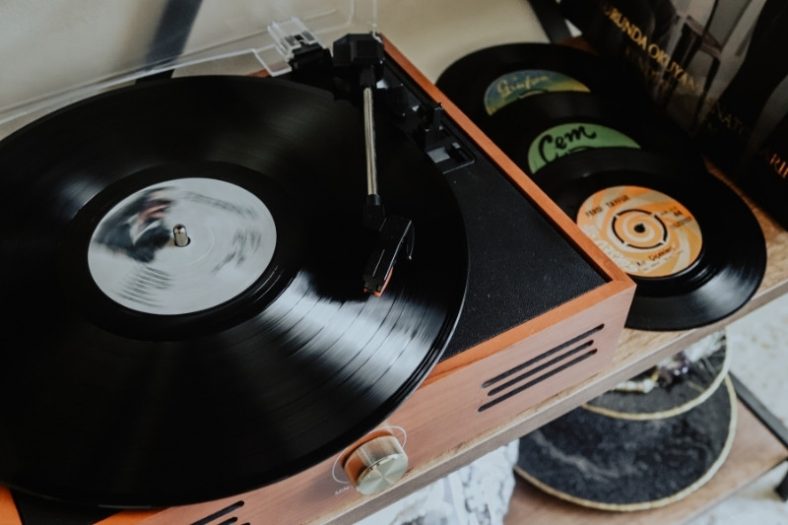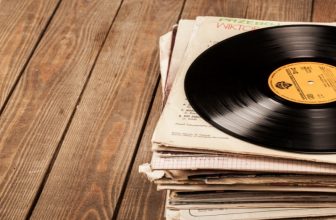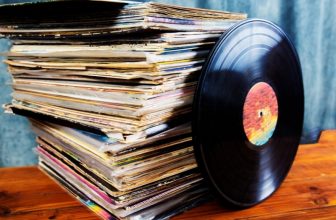Turntable Vs Record Player – What’s the Difference?

A turntable is a component of a record player—the platter in which vinyl records are placed—that doesn’t include a built-in amp or speakers, whereas a record player is a complete audio system featuring a built-in amp and speakers.
Turntables and record players can both be acquired separately as standalone audio equipment. However, a turntable is just part of a record player and needs to be paired with an external amp and speakers to function correctly. Record players, on the other hand, already contain all the components necessary to play vinyl records.
Does that mean you should always get a record player? Not exactly. To understand the differences between the two, we need to dig deeper into the advantages and disadvantages of turntables and record players.
Contents
What is a turntable?
A turntable is a platter in which vinyl records are placed. But it’s also a standalone unit that includes other components, such as a stylus, cartridge, and center spindle. In this case, a turntable can be described as a piece of audio equipment designed to play vinyl records.
A turntable contains all the components necessary to play vinyl records at home, except for a built-in amp and speakers. This means that you’ll have to acquire an external amp and set of speakers to use a turntable like a record player.
How does a turntable work?
A turntable works by converting sound vibrations (generated by the contact between the stylus and a record’s grooves) into electric signals. These electric signals must later be fed into an amp (so they get louder) and a set of speakers (so they can be reproduced).
What is a record player?
A record player is a standalone unit that’s used to play vinyl records. A record player features all the components of a turntable and also includes a built-in amp and speakers. A record player is hence a ready-made solution for listening to records at home: no additional components are necessary.
One can think of a record player as the extended version of a turntable. Record players are just like turntables, but they come with all the components needed to play vinyl records on the go. Due to the added features, standalone record players are normally much larger than standalone turntables.
How does a record player work?
A record player works similarly to a turntable: sound vibrations are converted into electric signals, which are later driven through an amp and reproduced by a set of speakers. The main difference is that record player units already include the amp and speakers.
What is the difference between a turntable and a record player?
A turntable is a piece of audio equipment that requires an external amp and speakers to play records, whereas a record player is an all-in-one piece of audio equipment that already comes with a built-in amp and speakers.
Record players are independent audio units that contain a turntable (as a component), while turntables need to be connected to an external amp and speakers to play vinyl records. It’d be easy to assume that record players are better than turntables, just like complete cars are better than just car engines. So, why do both continue to be produced?
Turntables vs. record players: a quick comparison
Turntables and record players have different advantages and disadvantages and serve different consumer needs. If you don’t know whether you should buy a turntable or a record player, the following considerations should be helpful:
- Turntables are versatile, record players are not. If you care about sound quality, then you should consider getting a turntable over a record player. Record players already feature a built-in amp and speakers, but these may not always be as top-quality as you wanted. Since turntables need to be connected to an external amp and speakers, you can choose whatever amp and speakers fit your needs and budget the best.
- Record players are more convenient than turntables. If your goal is to listen to your collection of vinyl records at home without going through too much of a hassle, you should probably get a record player. They’re convenient because they already feature everything you need to listen to music: you just have to plug them in, and you’re ready to go.
- Turntables are smaller than record players. While turntables require additional equipment to function properly, they’re much smaller than record players. They can be conveniently transported from one place to the other, and they can fit easily on a small shelf or even inside a backpack. Record players are much bulkier and harder to move.
- Unlike record players, turntables can be used for other functions. Namely, DJing. While it’s technically possible to DJ using a record player, no proper DJ would want to perform live using a record player’s built-in sound system (not to mention its sheer size). If you’re a professional DJ, you should get a DJ’s turntable, as top-quality DJ turntables can also be used for listening to vinyl records at home.
How to set up a turntable/record player?
- Place your turntable on a leveled surface. This way, you prevent record warping over time and ensure that there’s proper contact between the stylus and the records’ grooves.
- Connect the turntable to a preamp. First, make sure your turntable doesn’t have a preamp already: take a look at the back of the turntable and see if there’s a Phono-Line switch. If you can’t find one, then your turntable needs to be connected to a preamp. Turntables are connected to preamps using RCA cables. Make sure that the red RCA tip is connected to the red inputs and that the white RCA tip is connected to the white inputs.
- Connect the turntable to the speakers. Keep in mind that passive speakers require an additional piece of equipment known as a receiver. If there’s a volume knob on the back of your speakers, then that means they’re active and don’t need a receiver. Use copper wires to connect the speakers to the turntable. Ensure that you’re connecting your left speaker to the turntable’s left input (L) and your right speaker to the turntable’s right input (R).
What makes a good turntable/record player?
- A stable cartridge. Elliptical cartridges are the most common and recommendable because they offer a great degree of stability. Stability is important for two reasons: because you want your stylus to be as in-touch with the record as possible (a more precise contact means that more information will be extracted from the record) and because it prevents record wear. If your record and cartridge aren’t leveled, then your vinyl records will end up paying the price.
- A reliable speed. Vinyl records come in different speeds and sizes, so a turntable/record player must be able to play records at both 33 RPM and 45 RPM (the vast majority does). You should also look for turntables/record players with user-adjustable speed control, as this is a good indicator of belt drive accuracy. Nowadays, you can use a smartphone to quickly test a turntable’s speed.
- A heavy platter. Good-sounding turntables/record players vibrate the least. To ensure flawless sound quality, you should look for a heavy platter. Heavy platters are more stable, meaning they’re less prone to be affected by vibrations caused by anything from uneven surfaces to tiny movements occurring in the structure of the turntable/record player.
- Good, durable materials. Pretty much like any other top-quality product, the best turntables/record players are made of the best materials. Well-made products are more expensive, but they come cheap in the long run because they’re more durable.
Conclusion
Many music lovers simply feel that vinyl sounds better than digital storage of music (read our article on that to get a more detailed answer to that question!). Whether you’re doing so on a convenient record player or a more versatile turntable, the number-one goal should be to enjoy the sounds of your favorite artists and have fun with your collection of records.





